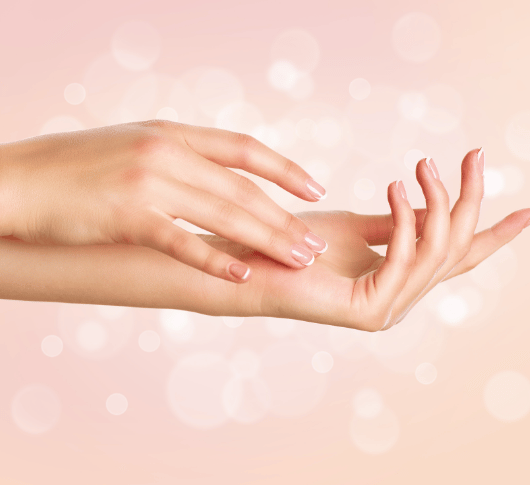

As we grow older, visible signs of ageing commonly appear on our hands, such as wrinkles, age spots, thinning skin, prominent veins, and loss of volume.
This is because our hands are constantly exposed to environmental stressors and used frequently. Plus, the skin on our hands is naturally thinner than on our face, making it more susceptible to damage and age-related changes over time.

Intrinsic ageing leads to a gradual breakdown of collagen and elastin, along with hormonal changes such as those during menopause.

Prolonged sun exposure causes UV damage, while frequent contact with water and harsh chemicals accelerates skin ageing.

Repetitive hand movements and daily wear contribute to visible signs of ageing over time.


Often affects the back of the hands, knuckles, and finger joints.
Can appear on the wrists and forearms, as well as the area between the fingers and thumb.
May impact the nail beds and cuticles, with veins becoming more prominent over time.
Everyone can be affected, but signs of ageing hands are particularly common in individuals over 40, becoming more pronounced after the age of 50.
Women often notice these changes earlier due to hormonal fluctuations during perimenopause and menopause.
People with fair skin, those who spend significant time outdoors, healthcare workers, hairdressers, and individuals in manual occupations are at higher risk. Genetics also play a key role in determining when and how severely the hands show signs of ageing.

Discover our range of expert-led treatments, including advanced facial aesthetics, body sculpting, skin health, and everyday beauty essentials.
Join our mailing list for exclusive offers, expert skin tips, and the latest updates on advanced treatments.

While ageing is a natural process that cannot be fully reversed, many of its visible effects can be significantly improved with appropriate treatments. Combining preventative care with professional therapies can restore a more youthful appearance, improve skin texture, and reduce pigmentation. However, maintaining results requires ongoing care and protection from environmental factors.
You can greatly slow its effects by applying daily SPF protection, moisturising consistently, wearing gloves during household chores, and embracing a healthy lifestyle.
Most age spots are harmless pigmentation changes. However, any new, changing, or irregularly shaped spots should be examined by a dermatologist to rule out skin cancer.
Yes, quality hand creams containing ingredients like retinol, hyaluronic acid, and SPF can help improve skin texture, hydration, and prevent further damage when used consistently.
In some cases, certain signs can indicate underlying health conditions. For example, sudden changes in skin texture or colour could signal circulatory problems or dermatological diseases. Excessively dry or brittle nails may point to nutritional deficiencies or systemic issues. If you notice unusual or rapid changes in your hands’ appearance, it is advisable to seek medical advice.
Stay informed with expert advice, treatment highlights, and clinic updates curated by the Cannelle Skin Clinic team.